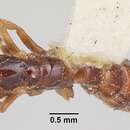Taxonomic History
provided by Antweb
Acanthostichus texanus Forel, 1904e PDF: 168 (q.) U.S.A. (Texas). Nearctic. Primary type information: Type-material: holotype queen. Type-locality: U.S.A.: Texas, Brownsville (
Wickham). Type-depository: probably MRHN (“Musée de Bruxelles”).
AntCat AntWiki HOLTaxonomic history
MacKay, 1996 PDF: 168 (w.).Combination in
Acanthostichus (Ctenopyga):
Emery, 1911e PDF: 14.Combination in
Ctenopyga:
Brown, 1975 PDF: 42.Combination in
Acanthostichus:
MacKay, 1996 PDF: 168.Status as species:
Wheeler, 1908h PDF: 400;
Wheeler, 1910a PDF: 561;
Emery, 1911e PDF: 14;
Creighton, 1950a PDF: 59;
Smith, 1951c PDF: 782;
Smith, 1955b PDF: 49;
Smith, 1955c PDF: 99;
Smith, 1958c PDF: 110;
Kusnezov, 1962a PDF: 133;
Smith, 1967a PDF: 345;
Brown, 1975 PDF: 42;
Smith, 1979: 1334;
Bolton, 1995b: 54;
MacKay, 1996 PDF: 168 (redescription).Senior synonym of
Acanthostichus townsendi:
Smith, 1955b PDF: 49;
Smith, 1955c PDF: 99;
Smith, 1958c PDF: 110;
Brown, 1975 PDF: 42;
Smith, 1979: 1334;
Bolton, 1995b: 54;
MacKay, 1996 PDF: 168.
- bibliographic citation
- AntWeb. Version 8.45.1. California Academy of Science, online at https://www.antweb.org. Accessed 15 December 2022.
Distribution
provided by Catalog of Hymenoptera in America North of Mexico
Tex.; Mexico.
- bibliographic citation
- Catalog of Hymenoptera in America North of Mexico. 1979. Prepared cooperatively by specialists on the various groups of Hymenoptera under the direction of Karl V. Krombein and Paul D. Hurd, Jr., Smithsonian Institution, and David R. Smith and B. D. Burks, Systematic Entomology Laboratory, Insect Identification and Beneficial Insect Introduction Institute. Science and Education Administration, United States Department of Agriculture.
Brief Summary
provided by EOL authors
This species is primarily subterranean and preys on termites (Gnathamitemrmes tubiformans). One method of finding workers involves looking under cow manure pats, where they may be preying on termites. Workers have most commonly been found in the autumn and winter (October through December).
Distribution
provided by EOL authors
Northeastern Mexico and southeastern Texas

